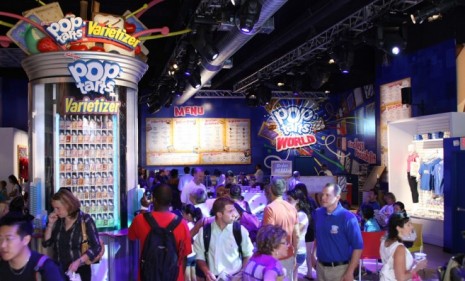Dining out at...Pop-Tarts World?
Thought Times Square had enough gimmicky theme eateries? Think again. Kellogg's has opened a store in Manhattan devoted entirely to Pop-Tarts

Hoping to boost sales of its Pop-Tarts line, Kellogg's has rented a 3,200 square-foot retail space in New York's Times Square to promote the toaster-ready pastry. (Watch a local report about the store.) Here's a quick guide to Pop-Tarts World, which opened this week:
Why an entire store dedicated to Pop-Tarts?
Kellogg's is trying to capitalize on Americans' fondness for the sugary treats, says The New York Times. Though it sells about two million Pop-Tarts a year, with sales of about $481 million, making it one of the company's more popular brands, sales still lag behind those of rival indulgences such as M&M and Hershey — both of which have marquee stores in Times Square. The goal, says a branding expert quoted by the Associated Press, is to bring "relevance and interest to a brand that has been around for a while."
The Week
Escape your echo chamber. Get the facts behind the news, plus analysis from multiple perspectives.

Sign up for The Week's Free Newsletters
From our morning news briefing to a weekly Good News Newsletter, get the best of The Week delivered directly to your inbox.
From our morning news briefing to a weekly Good News Newsletter, get the best of The Week delivered directly to your inbox.
What does Pop-Tarts World sell?
Why, Pop-Tarts, of course, but not the sort your local grocery store stocks. Kellogg's has concocted a series of 30 (sometimes "horrifying") twists — including peanut-butter-and-Pop-Tarts-stuffed celery sticks. Visitors can also sample "Pop-Tart sushi" (three different types of Pop-Tart, minced and wrapped in a fruit roll-up) or customize their own box of Pop-Tarts using a machine called "The Varietizer." (See the full menu here.)
How long have Pop-Tarts been around exactly?
Kellogg's introduced them in 1964 to compete with "Country Squares," a similar product from its key rival, Post. While Pop-Tarts thrived, partly due to its slim association with the buzzy Pop Art movement, the Post snack soon disappeared.
A free daily email with the biggest news stories of the day – and the best features from TheWeek.com
Will Pop-Tarts World actually sell many Pop-Tarts?
The initiative is less about sales than marketing and visibility, says Stephanie Clifford at The New York Times. It may not sell many Pop-Tart sushi rolls, but millions of tourists will see the store-front. Kellogg's hopes for a short-term brand boost may come to fruition, says the AP's Sarah Skidmore, but "it's unclear whether a store based on the novel combinations of how to eat a toaster pastry will have lasting success."
Is "lasting success" the goal?
Not necessarily. Kellogg's has only rented the space (at roughly $1,000 per square foot) until January of 2011, and will make a decision on the store's future then. With about "20 grams of sugar in a 54 gram serving," says Colin Sterling at The Huffington Post, it could be a "massive blunder" for Kellogg's to continue to devote a store to this "astonishingly unhealthy" snack. Then again, given America's voracious appetite for fatty foods, it could be a "brilliant" move.
Sources: New York Times, Associated Press, Huffington Post, Gawker, Eater NY


